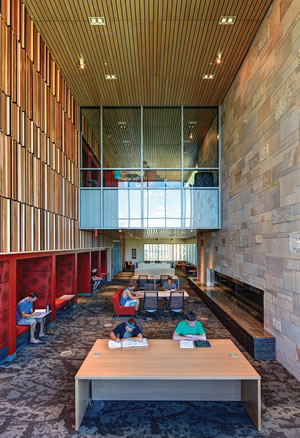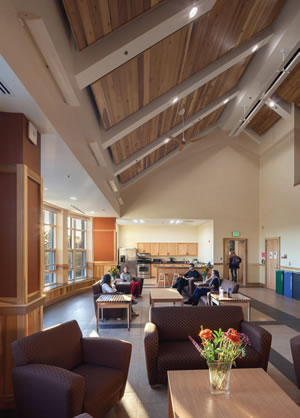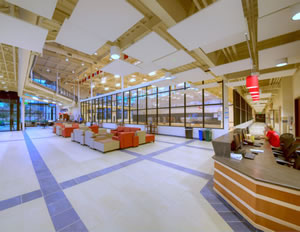On the Surface

PHOTO COURTESY OF SHW GROUP
You may not find it at the top of any administrator’s list. But the need to provide adequate upkeep of ceilings, walls and floors in campus buildings is an ongoing concern.
Making the effort to maintain interior surfaces offers a number of pluses, not the least of which is the importance of making a good impression in student recruiting, according to Lou Galante, associate director of building operations at the University of Iowa.
“Parents and students will choose a campus that is well maintained and does not have a degrading look to it,” he says. “Tuition at most colleges and universities is a premium, so all will tend to look at those that have the best facilities.”
Galante notes that the condition of walls and ceilings may be an indication as to what importance an institution places on maintenance.
“Usually if it looks good from the surface, it is maintained very well behind what you can’t see,” he says.
While few would argue with this assessment, other facility needs often garner more attention.
“University facility officers understand the importance of building life safety issues and other essential building characteristics like a dry building envelope, water, electricity, and heating and cooling,” says Peter Strazdas, associate vice president, facilities management at Western Michigan University in Kalamazoo. “With these high priorities, interior surfaces or the cosmetics inside a building seem to get pushed down the priority list.”
Assigning Priorities
Planning for basics such as walls and ceilings may not be as complex as with larger projects. But careful analysis still pays off. At Western Michigan, an annual condition analysis of interior spaces guides plans for upkeep. During the summer, students grade the floors, walls, ceilings and other interior features such as plumbing fixtures, whiteboards and window treatments.

PHOTO COURTESY OF HASTINGS & CHIVETTA ARCHITECTS, INC.
LOOKIN’ GOOD. It’s common knowledge that appearances matter, and well-maintained environments are safer as well. Establishing a formalized program to clean and maintain interior surfaces — floors, walls and ceilings — benefits the entire campus community.
“Since most of our customers are students, we use students to provide their interpretation of the interior surface condition,” Strazdas says. “It’s always good to get a different set of eyes to look for issues.”
Results of the analyses are used to generate lists of obvious issues, such as stained ceiling tiles, missing floor tiles, and other interior surface deficiencies or unsightly items. Managers then make entries in the work order system for prompt follow-up.
“Summer months are the best times for our skilled trades to perform these repairs,” Strazdas says. “It’s a great way to get rid of the obvious or embarrassing items that people in the building see but don’t recognize as an issue.”
In the process, staff members assign priorities to interior spaces and grade the surface conditions. The main vestibule is given a higher priority than a hallway, and a classroom is addressed before an office space.
Not surprisingly, classrooms typically receive extra emphasis.
“One way to look at this is asking where there are more footprints in a building on an average day,” Strazdas says. “We take our higher priority spaces and then overlap that list with the lowergrade surfaces.” Staff members consider the process of selecting spaces and surfaces for upgrades as an essentially objective one, taking out the subjectivity on where to place resources. Results have been positive and have helped in conserving resources and promoting sustainability for the future.
“Our classrooms and main entryways have never looked better,” Strazdas notes. “This has also led to a higher-grade carpet material in our vestibules and a higher-grade walk-off product past the vestibules. Not only does it look better at our main building entry points, but there is less dirt carried into the building.”
A systematic process also guides planning at Missouri State University (MSU), according to Bob Eckels, director of facilities management.

PHOTO COURTESY OF TMP ARCHITECTS, INC.
“We track deferred maintenance and keep a prioritized list for execution when funding is made available,” says Eckels. “We depend upon our facilities staff to report on those deficiencies as they conduct their daily routine work.”
In addition, MSU colleges routinely alert facilities staff to their needs. A monthly space management advisory committee reviews requests for space functional or physical changes, often including renovations. And a monthly projects review with the vice president addresses current projects, as well as concerns for renovation needs throughout the campus. Based on the information generated, major decisions are made to proceed with renovations that can be executed with available funds.
Sprucing Things Up
One advantage with facilities such as walls and ceilings is the relative simplicity of maintaining them.
“Probably the most cost-effective sprucing up can be done with merely some patching of walls and a well-chosen coat of a paint,” Eckels says. “Drop-in ceilings can be given a new look with replacement of ceiling tile, preceded by cleaning of the ceiling grid system.” He adds that replacement of ceiling lights with LEDs can be cost-effective, with energy savings covering the cost within just a few years. Flooring can be more costly, but use of carpet squares allows for replacement of carpet in the high-traffic areas without causing for complete re-carpeting years later.
Strazdas suggests dealing with less surface area and using a more durable product.
“A high-end walk-off carpet will take the abuse and wear a lot better than an inexpensive product at your entryways,” he says.
Standardizing ceiling tiles is another economical approach, he adds, offering a cost-effective way to easily replace a stained tile in short order. Painting the ceiling track also offers an efficient way to improve appearances.
For walls and doors, Strazdas advises investing in corner guards or kick plates. Horizontal wall guards may also be advisable if there are dining carts or other items that students or staff can push down a hall and damage doors or walls.
“The best paint job will be ruined in a short period of time,” he says. “It’s too costly to paint frequently, and human nature seems always to include bumping into walls and doors.”
He adds that even modest efforts to improve appearances can pay dividends, and may also influence the behavior of users.
“If a space looks bad, you will find that students treat it poorly,” he says. “Once we upgrade the interior surfaces, the students seem to treat the space better and there is less trash.”
Certainly from a budgetary viewpoint, investing in such basics makes good sense, according to Eckels. He says that since campus facilities are expected to be around for many years, decisions should be based upon “life-cycle” costs.
“In the long term, quality equipment and materials will be less expensive to maintain,” Eckels says. “It is really the right answer to controlling budgets in the future as facilities staffing and funding becomes scarcer.”
THE PAINT SHOP
For some colleges and universities, a dedicated staff is focused on painting and related maintenance tasks in order to keep facilities looking their best. Examples include:
- At Purdue University in West Lafayette, IN, under Central Shops, the Paint Shop “is a team of professionals dedicated to maintaining the physical environment of the interior and exterior of all academic campus buildings. This includes maintenance painting and wallcovering repair and installation in classrooms, corridors, laboratories, offices, restrooms, stairwells and building exteriors.”
- For Williams College in Williamstown, MA, the Paint Shop staff “is responsible for the maintenance of finishes of campus building systems such as walls, doors, windows, ceilings, stairways, decks, floors, campus signage, furniture, wall covering, scaff olding, drywall/plaster and traffic/pavement markings,” as well as other more general carpentry and related duties.
- At Amherst College in Amherst, MA, the Paint Shop is responsible for “all painting, wallpapering, glazing, ceramic tile work, floor sanding and lead paint abatement,” and staff perform annual painting assessments.
- As part of the Facilities Services department at Marquette University in Milwaukee, Painting Services “is responsible for maintaining the painted surfaces within buildings and on building exteriors.” These services include painting of building interiors and exteriors, hanging of vinyl wall coverings and their repair, removal of graffiti and gymnasium floor and other hardwood refinishing.
This article originally appeared in the issue of .